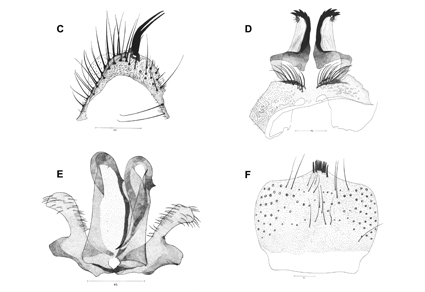Abstract
Theobaldia indica Edwards, 1920, classified as a subspecies of Culiseta (Culiseta) alaskaensis (Ludlow, 1906), was recently restored to its original species status, as Culiseta (Culiseta) indica (Edwards), based on comprehensive assessments of morphological, ecological and distributional data. Predating the recognition of indica as a separate species, we collected specimens of this nominal taxon in the Western Himalayan region of India during 2015–2017, and used morphological and molecular studies to assess its taxonomic status. Our detailed examination of adult morphology, male genitalia and larval characteristics revealed significant distinctions between putative Cs. alaskaensis alaskaensis and Cs. alaskaensis indica, and sequencing of the barcode region of the mitochondrial COI gene yielded a Kimura 2 parameter genetic distance of 5.9% between them, well above the standard 2‒3% commonly accepted to indicate separate species. These results strongly support the formal recognition of Cs. indica as a separate species. Furthermore, the geographical distribution of Cs. indica provides additional evidence in support of its species status.
References
- Azari-Hamidian, S. & Harbach, R.E. (2009) Keys of the adult females and fourth-instar larvae of the mosquitoes of Iran (Diptera: Culicidae). Zootaxa, 2078 (1), 1‒33. https://doi.org/10.11646/zootaxa.2078.1.1
- Barraud, P.J. (1924) A revision of the culicine mosquitoes of India. Part XVI. The Indian species of Theobaldia Neveu-Lemaire. Indian Journal of Medical Research, 12, 139–143, 2 pls.
- Barraud, P.J. (1934) The fauna of British India, including Ceylon and Burma. Diptera. Vol. V. Family Culicidae. Tribes Megarhinini and Culicini. Taylor and Francis, London, xxviii + 463 pp., 8 pls.
- Becker, N., Petrić, D., Zgomba, M., Boase, C., Madon, M., Dahl, C. & Kaiser, A. (2020) Mosquitoes: identification, ecology and control. 3rd Edition. Springer Nature Switzerland AG, Cham, xxxi + 570 pp. https://doi.org/10.1007/978-3-030-11623-1
- Carpenter, S.J. & LaCasse, W.J. (1955) Mosquitoes of North America (north of Mexico). University of California Press, Berkeley, Los Angeles, London, vii + 360 pp., 127 pls. https://doi.org/10.1525/9780520325098
- Chan, A., Chiang, L.-P., Hapuarachchi, H.C., Tan, C.-H., Pang, S.-C., Lee, R., Lee, K.-S., Ng, L.-C. & Lam-Phua, S.-G. (2014) DNA barcoding: complementing morphological identification of mosquito species in Singapore. Parasites & Vectors, 7, 569. https://doi.org/10.1186/s13071-014-0569-4
- Edwards, F.W. (1920) Mosquito Notes. Bulletin of Entomological Research, 10 (2), 129–137. https://doi.org/10.1017/S0007485300043923
- Felt, E.P. (1904) Mosquitos or Culicidae of New York State. New York State Museum Bulletin, 79 (323), 241‒391, 57 pls., 391a‒391f, 393‒400.
- Giles, G.M. (1901) A plea for the collective investigation of Indian Culicidae, with suggestions as to moot points for enquiry, and a prodromus of species known to the author. Journal of the Bombay Society, 13, 592–610, 2 pls.
- Gutsevich, A.V., Monchadskii, A.S. & Shtakel’berg, A.A. (1974) Fauna of the U.S.S.R. Diptera. Vol. 3. No. 4. Mosquitoes Family Culicidae. Keter Publishing House Jerusalem Ltd, Jerusalem, iii + 408 pp. https://doi.org/10.5962/bhl.title.46321
- Harbach, E.L. & Knight, K.L. (1980) Taxonomists’ glossary of mosquito anatomy. Plexus Publishing, Inc., Marlton, New Jersey, xi + 413 pp.
- Harbach, R.E. & Knight, K.L. (1982) Corrections and additions to Taxonomists’ glossary of mosquito anatomy. Mosquito Systematics, 13 (2), 201–217. [for 1981]
- Harbach, R.E. & Wilkerson, R.C. (2023) The insupportable validity of mosquito subspecies (Diptera: Culicidae) and their exclusion from culicid classification. Zootaxa, 5303 (1), 1–184. https://doi.org/10.11646/zootaxa.5303.1.1
- Hebert, P.D.N., Ratnasingham, S. & de Waard, J.R. (2003) Barcoding animal life: cytochrome c oxidase subunit 1 divergences among closely related species. Proceedings of the Royal Society, Biological Sciences, 270 (Supplement 1), S96‒S99. https://doi.org/10.1098/rsbl.2003.0025
- Khalin, A.V. & Aibulatov, S.V. (2016) Diagnostic characters of the thoracic pleurites of mosquitoes (Diptera, Culicidae): Topology of setae in species of the genus Anopheles Meigen, 1818, Coquillettidia Dyar, 1905, Culex Linnaeus, 1758, Culiseta Felt, 1904, Lutzia Theobald, 1903, and Uranotaenia Lynch Arribalzaga, 1891. Entomological Review, 96 (8), 1041–1068. https://doi.org/10.1134/S001387381608008X
- Kimura, M. (1980) A simple method for estimating evolutionary rates of base substitutions through comparative studies of nucleotide sequences. Journal of Molecular Evolution, 16 (2), 111–120. https://doi.org/10.1007/BF01731581
- Kumar, N.P., Rajavel, A.R., Natarajan, R. & Jambulingam, P. (2007) DNA barcodes can distinguish species of Indian mosquitoes (Diptera: Culicidae). Journal of Medical Entomology, 44 (1), 1‒7. https://doi.org/10.1093/jmedent/41.5.01
- Ludlow, C.S. (1906) An Alaskan mosquito. Canadian Entomologist, 38 (10), 326‒328. https://doi.org/10.4039/ent38326-10
- Maslov, A.V. (1964) On the systematics of bloodsucking mosquitoes of the group Culiseta (Diptera, Culicidae). Entomologicheskoe Obozrenie, 43 (1), 193–217. [in Russian]
- Maslov, A.V. (1989) Blood-sucking mosquitoes of the subtribe Culisetina (Diptera, Culicidae) in world fauna. Smithsonian Institution Libraries and the National Science Foundation, Washington, D.C., xv + 248 pp., 1 pl. https://doi.org/10.5962/bhl.title.46351
- Monchadskii, A.S. (1951) The larvae of bloodsucking mosquitoes of the USSR and adjoining countries (Subfm. Culicinae) [in Russian]. Opredeliteli po faune SSSR [Tableaux analytiques de la faune de l’URSS]. Tom 37. Akademiia nauk SSSR, Zoologicheskiĭ Institut, Moskva [Moscow], 290 pp. Tamura, K., Stecher, G. & Kumar, S. (2021) MEGA11: molecular evolutionary genetics analysis version 11. Molecular Biology and Evolution, 38 (7), 3022–3027. https://doi.org/10.1093/molbev/msab120


